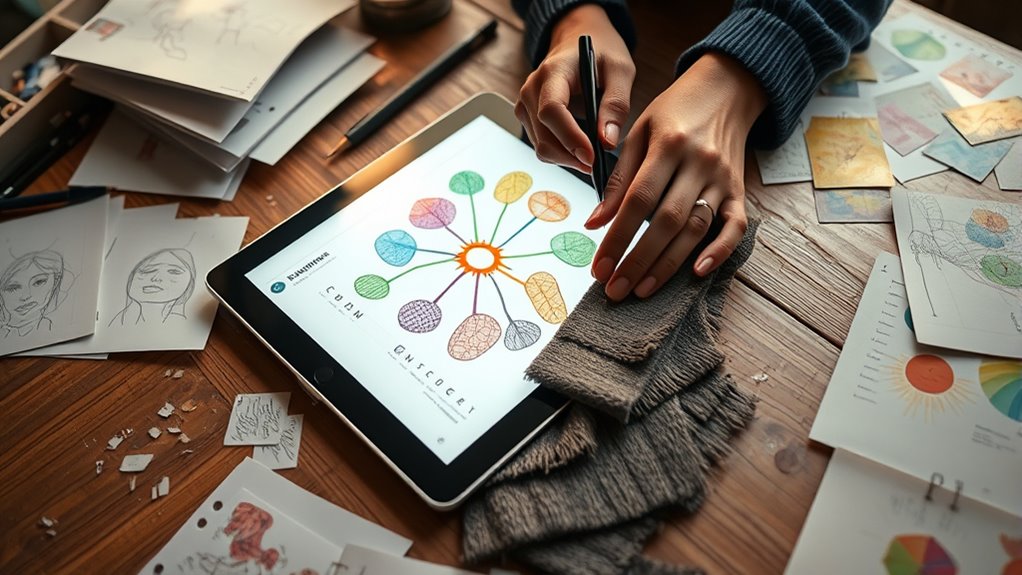To prototype emotional value effectively, focus on designing experiences that evoke genuine feelings through storytelling, sensory cues, and visual elements like color and texture. Test emotional responses by observing facial expressions, gestures, and physiological signals in real-time, and gather user feedback to identify what resonates or falls flat. Use iterative testing and emotional metrics to refine your approach continually. Explore more beyond the surface to craft truly meaningful, memorable connections with users.
Key Takeaways
- Use qualitative user research and storytelling to identify and test emotional triggers aligned with brand values.
- Incorporate real-time feedback, gesture, facial, and physiological data to observe genuine emotional responses.
- Employ sensory cues like color, texture, and sounds to evoke and measure emotional engagement during prototypes.
- Conduct iterative testing, refining prototypes based on emotional reactions and subtle user cues.
- Integrate emotional metrics and sentiment analysis to quantify and enhance the emotional impact of prototypes.
Understanding the Power of Emotional Value in Design

Have you ever wondered why some products resonate deeply with you while others leave you indifferent? It’s often because of the emotional value they carry. Emotional storytelling plays a pivotal role in creating this connection, making users feel understood and valued. To craft these meaningful experiences, empathy mapping is essential. It helps you step into your users’ shoes, uncovering their feelings, motivations, and pain points. By understanding their emotional landscape, you can design products that evoke genuine responses. This approach transforms a simple transaction into a memorable experience, fostering loyalty and trust. Recognizing the power of emotional value isn’t just about aesthetics; it’s about forging authentic bonds that influence user behavior and perceptions long after the initial interaction. Exploring different water parks can also inspire ideas for creating fun and engaging environments that evoke positive emotions.
Identifying Key Emotions to Test During Prototyping

Once you’ve identified the emotional values you want your product to evoke, the next step is to pinpoint which specific emotions to test during prototyping. Focus on emotional triggers that resonate most with your target users and foster genuine user empathy. Think about feelings like trust, excitement, comfort, or surprise—emotions that align with your brand and user needs. Consider how these emotions might influence user behavior and decision-making. Use qualitative insights from user research to guide your choices, ensuring you test emotions that truly matter. By clearly defining these key emotions, you create a focused testing process that reveals whether your prototype successfully evokes the desired emotional responses, helping you refine your design for maximum emotional impact. Incorporating spiritual fulfillment into your understanding of emotional experiences can also offer valuable perspectives on creating meaningful connections.
Methods for Creating Emotion-Focused Prototypes

To create emotion-focused prototypes that effectively evoke targeted feelings, you should employ a variety of design methods tailored to engage users’ emotional responses. One key approach involves leveraging emotional storytelling, crafting narratives that resonate deeply and activate arousal pathways in the brain. By embedding relatable stories or scenarios, you stimulate emotional reactions that mirror real experiences, fostering genuine connections. Additionally, using visual cues, sounds, or tactile elements can enhance emotional engagement by triggering specific arousal responses. Incorporating these methods helps you tap into the subconscious pathways that govern feelings, allowing your prototypes to evoke authentic emotional responses. Engaging with anime culture and storytelling techniques can further enrich your prototypes by adding layers of emotional depth. The goal is to design experiences that not only communicate value but also resonate on an emotional level, creating lasting impressions.
Incorporating User Feedback to Refine Emotional Impact

Incorporating user feedback is essential for refining the emotional impact of your prototypes because it provides direct insights into how real users respond to your design. By listening to their experiences, you deepen your understanding of their emotional storytelling and develop greater user empathy. This feedback reveals which elements resonate emotionally and which fall flat, guiding you to make targeted adjustments. Engaging users in conversations about their feelings helps you identify subtle cues that evoke connection or disconnection. As a result, you can craft prototypes that better mirror genuine emotional responses, strengthening the authenticity of your design. Additionally, understanding content-driven insights allows you to align your prototypes more closely with users’ emotional narratives, ensuring a more impactful and meaningful emotional experience. Ultimately, continuous user input ensures your prototype evolves to evoke meaningful, relatable feelings, making the intangible aspects of emotional value more tangible and impactful.
Using Visual and Sensory Cues to Evoke Feelings

Colors and mood can instantly influence how people feel about your product or message. Texture and touch add another layer of connection, making experiences more memorable. By intentionally using these visual and sensory cues, you can evoke specific emotions and strengthen your audience’s response. Incorporating color psychology into your design can further enhance the emotional impact of your messaging.
Color and Mood
Visual and sensory cues play a powerful role in shaping mood, as they influence how you feel without you even realizing it. Color psychology shows that different hues can evoke specific emotions, impacting your overall mood. For instance, blue often promotes calmness and focus, while red can energize and excite. By carefully selecting colors, you can enhance mood and create the desired emotional atmosphere. This technique, known as mood enhancement, leverages visual cues to subtly influence perceptions and feelings. When designing prototypes, consider how color choices communicate your brand’s personality and foster emotional connections. Using color intentionally allows you to craft environments and experiences that resonate on an emotional level, making your message more memorable and effective. Incorporating interior design principles such as layering textures and colors further amplifies the emotional impact and creates a cozy, inviting atmosphere.
Texture and Touch
Texture and touch are powerful tools for evoking feelings because they engage your senses directly, creating an immediate emotional response. Tactile feedback allows you to connect more deeply with a product, influencing how it feels and how you perceive it emotionally. Carefully selecting materials enhances this connection; smooth surfaces might evoke comfort, while rough textures can evoke excitement or ruggedness. When prototyping, consider how different textures influence user feelings and reactions. Your choice of material impacts not just appearance but also the emotional experience, making touch an essential element in conveying intangible value. Additionally, understanding the essential features of a product helps tailor the tactile experience to meet user expectations and needs. By intentionally designing for tactile feedback, you can evoke specific feelings and deepen emotional engagement, turning a simple object into a meaningful experience.
Measuring Emotional Responses With Innovative Tools

You can now explore how emotional reaction metrics reveal genuine feelings in real time. Innovative tools like biometric sensors and facial recognition provide immediate insights into responses. These technologies help you measure emotions accurately and adapt your approach quickly. Understanding the role of love in relationships can enhance your interpretive skills when analyzing emotional data.
Emotional Reaction Metrics
Measuring emotional responses has traditionally relied on self-reports, which can be biased or unreliable. To get more accurate insights, you can now use emotional reaction metrics, powered by innovative tools like sentiment analysis. These tools analyze facial expressions, voice tone, and physiological data to gauge genuine emotional responses in real time. Unlike surveys or interviews, which depend on conscious self-assessment, these metrics capture subconscious reactions, providing a clearer picture of how your audience truly feels. Sentiment analysis, in particular, helps interpret vast amounts of unstructured data, revealing patterns and emotional trends. Incorporating emotional engagement metrics allows for a deeper understanding of audience reactions. By integrating emotional reaction metrics into your testing process, you gain more precise, actionable insights that inform your prototypes and enhance emotional engagement.
Real-Time Response Analysis
How can real-time response analysis revolutionize the way you understand emotional reactions? By leveraging gesture recognition and innovative tools, you can capture immediate, authentic responses during emotional storytelling. This approach allows you to observe subtle gestures, facial expressions, and body language as they happen, providing richer insights into how your audience truly feels. Unlike traditional surveys, real-time analysis uncovers spontaneous reactions, helping you refine your messaging or product design on the spot. Integrating these technologies enables you to track emotional shifts, identify engagement points, and better tailor your prototypes to evoke desired responses. This method is especially valuable in sensitive areas like emotional support and understanding individual reactions during stressful situations, such as legal proceedings. Ultimately, this dynamic feedback loop enhances your ability to test and optimize intangible elements—like emotional value—more effectively and efficiently.
Iterating and Validating Your Prototype for Maximum Emotional Resonance

To create a truly emotionally resonant prototype, it’s essential to iterate and validate your design based on genuine user feedback. Use storytelling techniques to uncover how users emotionally connect with your prototype. Share stories that reveal their feelings, motivations, and pain points, helping you refine the emotional impact. Incorporate empathy mapping to understand users’ emotional states and perspectives deeply. This process highlights what resonates and what falls flat emotionally. Test your prototype repeatedly, observing reactions and gathering honest feedback. Each iteration should bring you closer to aligning your design with users’ emotional needs. Remember, validation isn’t just about functionality—it’s about ensuring your prototype evokes the intended emotional response, building a meaningful connection that lasts.
Frequently Asked Questions
How Can Emotional Value Influence User Loyalty and Brand Perception?
Emotional value deeply influences your user loyalty and brand perception. When you use emotional storytelling, you create meaningful connections that resonate with your audience. Empathy mapping helps you understand their feelings and needs better, allowing you to craft experiences that evoke genuine emotions. These strategies foster trust and loyalty, making users more likely to stick with your brand and view it positively, ultimately strengthening your brand’s reputation and customer relationships.
What Are Common Pitfalls When Prototyping for Emotional Impact?
When prototyping for emotional impact, you might fall into common pitfalls like neglecting emotional authenticity or overlooking user vulnerability. If your prototype feels inauthentic, users won’t connect deeply. Also, ignoring user vulnerability can cause discomfort or mistrust. To avoid this, focus on genuine emotional expression and create safe spaces for users to share their feelings. This approach helps you build prototypes that truly resonate and foster loyalty.
How Do Cultural Differences Affect Emotional Design Testing?
You need to contemplate how cultural differences influence emotional design testing because cross-cultural nuances can shape emotional responses uniquely. While some emotions have emotional universality, others vary widely across cultures. By recognizing these differences, you can tailor your prototypes to better resonate with diverse audiences. Testing across cultures helps you identify which emotional elements are universal and which require adaptation, ensuring your design effectively connects on a deeper, more meaningful level.
Can Emotional Prototypes Be Scaled for Large User Testing?
Imagine scaling emotional prototypes to the size of a city! You can do this through advanced emotional mapping and empathy exercises that gather vast, nuanced insights. By leveraging digital tools and iterative testing, you make large-scale emotional testing feasible. This approach helps you understand emotional responses across diverse user groups, ensuring your prototypes resonate deeply on a broad level while maintaining authenticity and emotional accuracy.
What Ethical Considerations Arise When Manipulating Emotional Responses?
When you manipulate emotional responses, you need to consider ethical issues like emotional authenticity and consent considerations. You must ensure participants are fully aware of how their emotions might be influenced and agree to it. Respecting their emotional well-being is essential, so you should avoid causing harm or distress. Transparency fosters trust, and prioritizing genuine emotional experiences helps maintain ethical standards in your testing process.
Conclusion
You’ve just unfastened the secret garden of emotional design, where each prototype is a delicate seed waiting to bloom. By tuning into feelings and nurturing their growth with feedback and sensory cues, you craft experiences that resonate deep within. Remember, emotions are the compass guiding your journey—trust their whispers. Keep iterating, refining, and listening, and watch your creation transform from a rough stone into a shining gem, enthralling hearts with its genuine emotional hue.









